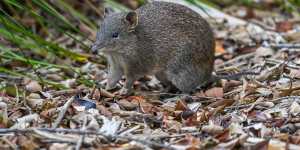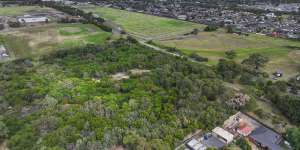The federal government decision clears the way for the removal of more than three hectares of woodland in Cranbourne for a series of townhouses up to three storeys high.

Southern brown bandicoots,like this one at Cranbourne Royal Botanic Gardens,still inhabit Melbourne’s south-eastern fringe but are losing ground.Joe Armao
Environment Minister Tanya Plibersek’s delegate granted approval despite an ecological study finding that a genetically important population of bandicoots inhabit the site and that clearing it will render the species more vulnerable.
The undeveloped property is about one kilometre north of the Cranbourne Royal Botanic Gardens,which is the southern brown bandicoot’s last urban oasis and a predator-free refuge to hundreds of the rabbit-sized marsupials.
The southern brown bandicoot once roamed widely throughout Melbourne’s south-east but has diminished in number since the city’s urban growth boundary was expanded,leading to its listing as an endangered species in 2013.
Its conservation status requires the federal environment minister’s approval for any development proposal that disturbs or reduces its habitat,under the Environment Protection and Biodiversity Conservation Act.

Rather than halt development around Cranbourne,new estates such as Botanic Ridge and Devon Meadows are being built with features aimed to protect bandicoots,such as dry culverts under roads and a ban on cat ownership.
Similar features have been proposed for the approved development at Cyril Beechey Lane in Cranbourne,a former farm that neighbours Cranbourne Racecourse.
The approval marks the end of a near 20-year quest for the landowner,who first sought to rezone the land for residential development in 2007 but was denied because of high-profile methane leaks in a nearby housing estate,which was built on top of a former tip.

This small woodland in Cranbourne will be cleared for housing,other than a 30-metre wide corridor for bandicoots.Joe Armao
The current housing proposal was first submitted for approval in 2019.
The developer,Brown Property Group,must preserve a 30-metre wide “fauna corridor” for the southern brown bandicoot along the eastern boundary of the site. The company is permitted to clear about three hectares of bandicoot habitat in Cranbourne,but not before it secures 10 hectares in Ocean Grange as a bandicoot reserve.
The company,which has developed several large estates in Melbourne’s south-east,was contacted for comment but did not respond.

David Nicholls,a research officer with the,lashed the decision,arguing it undermined “the tremendous efforts,by federal,state and local governments and local community to ensure the survival of this bandicoot close to Melbourne”.
The development risks “a death by a thousand cuts” for the bandicoot,which has lost vast areas of habitat to urban encroachment in recent decades,he said.
“The bandicoot has been lost in the sand-belt suburbs so any remaining habitat is important,” Nicholls said.
Pauline Deering,a conservation science student at Federation University who has surveyed bandicoot numbers with the recovery group,said the animal was under growing threat from environmental fragmentation.

Southern brown bandicoot researcher Pauline Deering searches for the marsupials in the woodland on the site.Joe Armao
“It is so important to keep those connected pieces of environment so that the bandicoot can traverse and meet up with others and not inter-breed,not just be confined to a small area where over time they just decrease[in number],” Deering said.
The southern brown bandicoot is known as an “ecosystem engineer” and has a key ecological role of turning over soil and providing essential nutrients to native plants.
The April 2 approval by the Department of Climate Change,Energy,the Environment and Water came three weeks after the Casey City Council voted to rezone the land from farming to general residential,paving the way for potential future housing of up to three storeys on the densely vegetated four-hectare site.
According to a report endorsed by the council,rezoning the land for residential development makes sense.
“The land is part of an established urban residential area and can be efficiently serviced;development of the land will fulfil a need for more housing stock within metropolitan Melbourne,” the report said.
A spokesperson for the Department of Climate Change,Energy,the Environment and Water said the development had been approved with strict conditions to protect the environment.
“A fauna corridor between the Royal Botanic Gardens and Grandeur Nature Reserve will help to maintain genetic diversity for the Cranbourne population as it will allow the population to travel (and genes to flow) between sites,” the spokesperson said.
The Morning Edition newsletter is our guide to the day’s most important and interesting stories,analysis and insights..